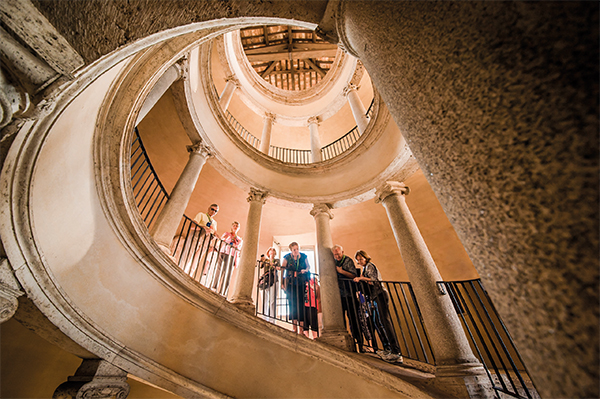The History of the Vatican
Museum's Bramante Staircase

The Sistine Chapel and its glorious ceiling painted by Michelangelo may be the Vatican’s most famous feature, but the caliber of architecture, art, and sculpture throughout the complex is in a class by itself.
Vatican City and the Vatican Museums
Vatican City is the smallest sovereign state in the world, at about 0.17 square miles, half of which is gardens. Surrounded by sprawling Roman neighborhoods, the historic Vatican Complex of plazas, porticos, and buildings is the heart of the Catholic Church and home to some magnificent architectural and artistic wonders. One of the most famous features of the Vatican Museum is the Bramante Staircase, designed by Donato Bramante.
The Two Bramante Staircases in the Pio Clementino Museum, Vatican City
The Bramante Staircase is an architectural marvel that comprises two spiral ramps, located in the Pio Clementino Museum. The first ramp was designed and built in 1505 by Donato Bramante, while the second was designed by Giuseppe Momo in 1932, as a tribute to the original. Both staircases are among the world's most recognized and photographed stairways.
The Original Bramante Staircase, 1505
The original Bramante Staircase, which was closed to the public, was designed by Donato Bramante to provide access to the residential upper floors and deliver whatever was necessary to the Pope. Bramante's original staircase, known as the "Bramante Double Helix Staircase," is an architectural marvel.
The "Bramante Double Helix Staircase" earns its name due to its unique architectural design featuring a double helix structure. This design allows visitors to ascend and descend simultaneously without crossing paths, as the staircase spirals upward in a double helix formation. The term "double helix" refers to the two intertwined helical structures, reminiscent of the double helix shape of a DNA molecule.
With a colonnade of 36 granite columns providing structural support, the steep spiral ramp ascends for four revolutions, paved in a herringbone pattern. Arched windows deliver ample natural light and spectacular views of Rome and the Vatican.
Italian Renaissance Architect and Painter, Donato Bramante
Donato Bramante, also known as Bramante Lazzari, was an Italian Renaissance architect and painter who became famous for his contributions to the High Renaissance style. He played a central role in designing many buildings in the Vatican Complex, including the current St. Peter's Basilica and the Belvedere Courtyard. Bramante's architectural designs were characterized by harmony, balance, and proportionality. His works are considered among the most important examples of Renaissance architecture and have influenced many architects throughout history. Visit his works on your trip to Italy, to appreciate his genius and creativity.

Giuseppe Momo's "Spiral Staircase," 1932
Giuseppe Momo, an Italian architect and sculptor, was known for his innovative designs and use of modern materials. The Momo-designed Bramante staircase is an exquisite blend of classic and modern architecture that is a joy to behold. It's often referred to as the "Spiral Staircase" as it features a beautiful double-helix structure, which is intended to give visitors a feeling of ascending into the heavens as they climb the stairs.
Italian Architect and Sculptor, Giuseppe Momo
Giuseppe Momo also played a part in numerous other architectural works in Rome, including the restoration of the Basilica di San Giovanni in Laterano and the design of the Palazzo dei Congressi. Despite controversy surrounding the modernization of the Vatican Museums, the new Bramante Staircase remains a popular attraction and is open to the public for viewing.
Frequently Asked Questions About the Bramante Staircases in Vatican City
There are two Bramante Staircases in Vatican City. The first Bramante Staircase, also known as the "Bramante Double Helix Staircase," was designed by Donato Bramante in the early 16th century. The second Bramante Staircase, often referred to as the "Spiral Staircase," was constructed in the late 1930s and is located nearby. Both staircases exhibit remarkable architectural design and are notable features of the Vatican Museums.
There are two Bramante Staircases in Vatican City. The first Bramante Staircase, also known as the "Bramante Double Helix Staircase," was designed by Donato Bramante in the early 16th century. The second Bramante Staircase, often referred to as the "Spiral Staircase," was constructed in the late 1930s and is located nearby. Both staircases exhibit remarkable architectural design and are notable features of the Vatican Museums.
The original Bramante Staircase was designed by the renowned Italian architect Donato Bramante.
The second Bramante Staircase, known as the "Spiral Staircase," was designed by Giuseppe Momo.
The original Bramante Staircases was built in the early 16th century, around the year 1505. It was commissioned by Pope Julius II and designed by the renowned Italian architect Donato Bramante.
The second Bramante Staircase, known as the "Spiral Staircase," was constructed in the late 1930s. It was designed by Giuseppe Momo as a solution to the increasing traffic flow within the Vatican Museums. This staircase mirrors the original Bramante Staircase but is located nearby and provides an alternative route for visitors.
The staircase is considered one of Bramante's architectural masterpieces and remain a highlight of the Vatican Museums to this day.
The Bramante Staircases are located within the Vatican Museums, specifically in the Pio-Clementine Museum section. These staircases serve as a connecting pathway between the Belvedere Palace and the Apostolic Palace (the residence of the Pope), providing access to the museum galleries and exhibition spaces.
The Bramante Staircases hold significant cultural, historical, and architectural importance for several reasons:
Architectural Innovation: Designed by Donato Bramante in the early 16th century, the Bramante Staircases represent a pioneering feat of architectural ingenuity. Their double helix design, which allows visitors to ascend and descend simultaneously without crossing paths, showcases Bramante's innovative approach to spatial design and engineering.
Renaissance Masterpiece: As one of the foremost architects of the Renaissance period, Donato Bramante played a crucial role in shaping the architectural landscape of Italy. The Bramante Staircases stand as a testament to his creative vision and technical skill, embodying the spirit of Renaissance innovation and craftsmanship.
Integration with Vatican Museums: Situated within the Vatican Museums, the Bramante Staircases serve as both functional elements and architectural highlights of the museum complex. Their seamless integration into the museum's architecture enhances the overall visitor experience while providing access to different levels of the museum galleries.
Cultural Symbolism: The Bramante Staircases are emblematic of the rich cultural heritage and artistic legacy of Vatican City and the broader Italian Renaissance. They symbolize the intersection of art, architecture, and spirituality, reflecting the Vatican's status as a custodian of world-renowned cultural treasures.
Overall, the Bramante Staircases hold multifaceted significance as architectural marvels, cultural landmarks, and symbols of artistic achievement, enriching the cultural tapestry of Vatican City and the wider world.
Double Helix Design: Unlike conventional staircases, the Bramante Staircases feature a unique double helix design, allowing visitors to ascend and descend simultaneously without crossing paths.
Architectural Innovation: Designed by Donato Bramante in the early 16th century, the original Bramante Staircase represents a remarkable architectural innovation for the time, incorporating both aesthetic appeal and functional efficiency.
Spiral Structure: While traditional staircases typically follow a linear or circular pattern, the Bramante Staircases spiral upwards in a helical form, creating a visually striking and dynamic architectural element.
Dual Accessibility: The dual helix design of the Bramante Staircases enables two separate staircases to intertwine within the same space, providing simultaneous access for ascending and descending traffic without congestion.
Spatial Integration: Rather than being isolated structures, the Bramante Staircases are integrated into the architecture of the Vatican Museums, seamlessly connecting different levels of the museum complex while enhancing the overall spatial experience for visitors.



















